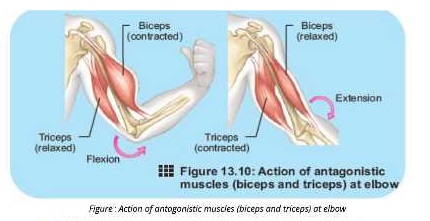Q.7 How skeletal muscles, are involved in the movement of the skeleton?
Answer:
When bones move at joints, they produce movement. The movements in bones are brought about by the contractions of skeletal muscles, which are attached with bone by tendons. The combination of several muscles bring about activities e.g, walking, running, playing etc.
Origin:
One end of skeletal muscle is always attached with some immoveable bone. This end of muscle is called origin.
Insertion:
Other end of muscle is attached with a moveable bone and is called insertion. Muscles can only contract or pull but cannot expand or push the bones. When muscle is stimulated by a nerve impulse, it contracts to become shorter and thicker. Due to this contraction, muscle pulls the moveable bone at insertion.
Role of Skeletal Muscles
(a) Antagonism:
Skeletal muscles are usually in pairs of antagonists. In an antagonistic pair, both muscles do opposite jobs. When one muscle contracts the other relaxes and this phenomenon is called antagonism or antagonistic action.
(b) Flexor:
When a muscle in an antagonistic pair contracts and bends the joints, it is called flexor muscle and movement is called flexion.
(c) Extensor:
When a muscle contracts and straightens the joint, it is known as extensor and the movement is called extension.
Example: (Movement of arm)
(a) Antagonistic
Pair Bicep and triceps are antagonistic pair of muscles and are involved in the movement of arm.
(b) Biceps
Biceps is a flexor muscle in front of the upper arm bone.
(c) Triceps
Triceps is an extensor muscle on the back of arm. Both of these muscles have their origin at pectoral girdle and insertion at one of the two bones of forearm. (
d) Working
When biceps contracts, the forearm (insertion end) is pulled upward. It is flexion of elbow joint. During this flexion, triceps muscle relaxes. When triceps contracts, forearm is pulled down. It is an extension at elbow joint. During it, biceps relaxes. Similar pairs, working antagonistically across other joints, provide for almost all the movements of skeleton.”

![]()